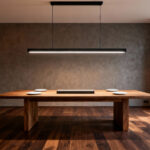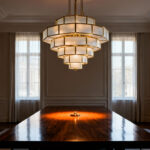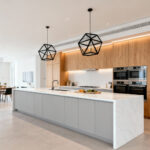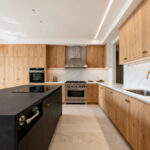Let’s be honest, the best parties always end up in the kitchen. It doesn’t matter how comfortable your sofa is or how perfectly calibrated your home theater is (and believe me, I know a thing or two about that). People gravitate towards the heart of the home. The kitchen is where stories are swapped over a glass of wine, where kids sneak tastes of cookie dough, and where the real connection happens. A rustic kitchen just leans into that fact. It’s more than a style; it’s an invitation to gather ’round.
Forget sterile, touch-me-not showrooms. A rustic kitchen feels grounded, real, and deeply human. It’s built from materials that tell a story—wood with a past, stone that feels cool to the touch, and metal with the honest heft of craftsmanship. You don’t need a log cabin in the mountains to capture this vibe. You just need a desire to create a space that puts people at ease and begs them to stay a while.
So, if you’re ready to transform your kitchen from a simple cooking zone into the social hub you’ve always wanted, I’ve got you. Here are 19 ideas that will infuse your space with that irresistible, memory-making rustic charm.
1. Get Serious with Exposed Wooden Beams
Exposed wooden beams are the undisputed heavyweight champion of rustic design. They just are. They have this incredible gravity—not just physically, but emotionally. They instantly connect a room to its structural roots, a nod to old-world construction where things were built to last. A room with beams just feels more permanent, more substantial. It’s the architectural equivalent of a firm handshake.

Now, here’s the thing. While nothing beats the history and soul of genuine reclaimed beams from an old barn or factory—every notch and nail hole telling a story—not every home can support them. And that’s okay. I’ve seen some incredible “faux” beams made from lightweight materials that, when finished correctly, can look shockingly good. The key is avoiding that glossy, plastic-y sheen. You want a matte or distressed finish that lets the wood’s (or wood-look’s) character shine. It’s all about creating that cozy, protective feeling of having a sturdy roof over your head.
Once you’ve got that ceiling drama sorted, your eyes will naturally drift downwards to the walls. And they present another killer opportunity for texture.
2. Go Bold with a Stone or Brick accent wall
There is nothing—and I mean nothing—that grounds a space like a wall of stone or brick. It’s a powerful move that adds immediate texture, history, and a raw, earthy honesty to the room. Think fieldstone, river rock, or reclaimed brick still showing the ghosts of old mortar. You want materials that look like they were pulled from the earth, not popped out of a perfect mold. They’re imperfect, and that’s what makes them perfect for this style.

The wall behind the range is a classic choice, creating an undeniable focal point that says “this is where the magic happens.” I’ve also had clients wrap the base of their kitchen island in a stone veneer, which is a fantastic way to anchor it in the room. Now, let’s be real: installing real stone is a heavy, professional job. But high-quality veneers and thin-brick systems have come a long way. The trick is to lay them out on the floor first. Mix and match to avoid weird clumps of color or size. It’s the one step people always skip, and it makes all the difference.
An accent wall provides the perfect textural backdrop. It’s the rhythm section of your kitchen band. Now, let’s talk about the lead singer: the sink.
3. Say ‘Yes’ to the Classic Apron Front Farmhouse Sink
The farmhouse sink is a total icon for a reason. It’s the workhorse centerpiece of a rustic kitchen, instantly conjuring images of a space that’s meant to be used and loved. That big, deep basin with its exposed front was born from pure practicality—it was big enough to wash canning jars, giant pots, and maybe even a small child. Its sheer size and utility give it a sense of enduring history that no sleek, undermount sink can match.

Fireclay is the go-to material. That classic, glossy white provides a stunning contrast against rugged wood or stone. But don’t sleep on other options! I’ve seen hammered copper sinks that develop the most beautiful patina over time, or soapstone sinks that look like they were carved right out of a mountain. Yes, you’ll need to make sure your cabinets are built to support the weight, but the payoff is a timeless focal point that’s as beautiful as it is functional. It’s less of a sink and more of a kitchen command center.
From that central, hardworking fixture, let’s look at how to handle your storage and display to keep the rustic character flowing.
4. Embrace the Story of Open Shelving
Okay, let’s talk about open shelving. I know some people get nervous about it. “Won’t it look messy?” But here’s my take: open shelving isn’t about showing off perfect, matching dish sets. It’s about telling your story. When you use reclaimed wood—with its knots, grain, and old nail holes—those shelves have a character all their own before you even put anything on them. They feel honest and alive.

Switching from bulky upper cabinets to open shelves instantly makes a kitchen feel bigger and more inviting. More importantly, it lets you turn your everyday items into art. That stack of mismatched ceramic bowls from the local art fair? The vintage coffee mugs you’ve collected? Suddenly, they’re part of the decor. It encourages a more relaxed, less formal vibe that’s the soul of rustic design. The trick is to leave a little breathing room. It’s a display, not a storage unit.
These shelves give you a place to show your personality, but you’ll still need cabinets for all the less-pretty stuff. Getting the finish right on those is what separates a good rustic kitchen from a great one.
5. Get a Little Scuffed Up with a Distressed Finish
Your kitchen cabinets take up a ton of visual real estate, so their finish is a huge deal. A distressed finish is your secret weapon for instant history and lived-in charm. We’re talking about intentionally sanding edges, adding a few artful nicks, or applying a glaze that settles into the crevices to mimic decades of use. It’s about making new cabinets look like they’ve seen a few generations of family dinners.

Here’s the part that social hosts and families will love: distressed cabinets are unbelievably forgiving. A new scratch from a kid’s toy or a ding from a guest who got a little too excited just adds to the character. It’s a low-stress finish for a high-traffic area. It gives you permission to actually live in your kitchen without worrying about every little mark. I once worked with a family with three young kids, and they said choosing distressed cabinets was the single best decision they made for their own sanity.
With the cabinets bringing the character, the surface you work on every day needs to be just as warm and inviting.
6. Warm Things Up with Butcher Block Countertops
Butcher block is the ultimate countertop for a rustic kitchen. Period. It brings a warmth and tactile connection to nature that you just don’t get from cold stone. Made from solid wood planks, it shows off beautiful grain and subtle color variations that feel alive. It’s soft to the touch and just feels…inviting. Butcher block has that timeless, hardworking heritage that’s at the core of the rustic vibe.

Now for the real talk: does it require maintenance? Yes. You have to be good about sealing it with food-safe mineral oil or another protective finish. You have to wipe up spills. But here’s how I see it: over time, it develops a patina. It collects the faint scars and stains of your life, telling the story of meals cooked and toasts made. It ages with you, becoming a truly personal part of your home. It’s a bit of a commitment, but the character it adds is more than worth the effort.
The warmth of wood is a foundation, but every great design needs a little sparkle—a little contrast to make the textures pop.
7. Add the Warm Glow of Copper Accents
If there’s one metal that was made for rustic kitchens, it’s copper. That rich, reddish-brown hue is the perfect partner for the earthy tones of wood and stone. What I love most is that copper is a “living finish.” It doesn’t just sit there; it ages. It develops a beautiful, complex patina over time, which is exactly what rustic design is all about—celebrating character and the passage of time.

You can go big or go small. A massive copper range hood or a hammered copper farmhouse sink makes a spectacular focal point. But you don’t have to break the bank. Copper pendant lights over the island, copper cabinet pulls, a gooseneck faucet, or even just a beautiful copper kettle left out on the stovetop can add that touch of warm shimmer. And bonus points: copper is naturally antimicrobial, so it’s a surprisingly practical choice for the kitchen.
Copper adds a warm gleam, but to really ground the space, you need a material with some serious heft.
8. Get a Grip with Timeless Wrought Iron Hardware
Wrought iron is the yin to copper’s yang. It’s dark, sturdy, and has this wonderful, handcrafted feel. Its matte, often slightly imperfect finish provides a fantastic visual contrast against both natural wood and painted cabinets. This isn’t flimsy, mass-produced stuff. Wrought iron feels substantial in your hand—it’s built to last, which taps right into the enduring, practical spirit of rustic style.

You can find it everywhere, from simple knobs and classic cup pulls to dramatic strap hinges for a true barn-door look on your cabinets. Think beyond the cabinets, too. A wrought iron pot rack hanging over the island or a chandelier with iron details creates a cohesive look that feels intentional and well-designed. Choosing a slightly ‘aged’ or ‘rusted’ finish can really amp up that antique, found-object feel. It’s the kind of small detail that makes a huge difference.
Hardware is the jewelry of the kitchen, but the island is the main event—the social centerpiece.
9. Go Big with a Sturdy, Oversized Rustic Island
This is it. If the kitchen is the heart of the home, the island is the heart of the kitchen. In a rustic design, the island should feel more like a sturdy piece of farmhouse furniture than a slick, built-in cabinet. Think big. Think substantial. Think of a surface large enough for rolling out dough, spreading out a buffet for a party, and having a few friends lean against it with drinks in hand.

An oversized island is the ultimate social hub. It provides a massive workspace, a central gathering spot, and a ton of storage in its base. One of my favorite moves is to design an island with a different material or finish from the rest of the cabinets, making it feel like a unique, standalone piece. A thick butcher block or a honed stone top on a reclaimed wood base is a classic combo. Just make sure you leave enough clearance—at least 36 to 42 inches—around all sides so people can move freely. This is where life happens.
While natural materials set the stage, you can add a massive dose of personality with some well-chosen workhorses.
10. Find Your Funk with Vintage or retro-style appliances
Here’s where you can have some real fun. Vintage or retro-style appliances inject so much personality and character into a rustic space. Their softer lines, classic colors, and chunky hardware provide a delightful break from all the wood and stone. They become conversation pieces, adding a nostalgic, whimsical touch that keeps the room from feeling too serious or theme-park-y.

Now, tracking down and restoring a genuine 1950s fridge can be a major undertaking. Thankfully, brands like Smeg and Big Chill are making brand-new appliances with all the modern energy efficiency and features, but with that incredible retro look. A mint green fridge or a range with big, satisfying chrome knobs can be the one piece that pulls the whole room together. It shows you’ve got a sense of humor and an appreciation for timeless style.
From the cool curves of the fridge, let’s look down to the foundation of the room itself.
11. Make a Statement with Wide Plank Wood Flooring
Wide plank wood flooring is the perfect anchor for a rustic kitchen. It just feels right. Historically, before modern milling made thin strips the norm, planks were cut wider from old-growth trees. Using them today immediately gives a space a sense of history and craftsmanship. The wider planks let the wood’s natural grain, knots, and character really stand out. It’s a bold, confident look that feels solid under your feet.

I know what you’re thinking: wood floors in a kitchen? It’s totally doable. You just have to be smart about it. Pick a durable hardwood like oak, hickory, or maple, and use a high-quality, water-resistant finish. A good rug in front of the sink helps, too. Or, look into engineered wide plank flooring, which is built in layers to be more stable against humidity changes. The warmth and continuous flow it brings to a space are well worth the little bit of extra care.
As we move from the floor to the doorways, another feature borrows from that old-world farm aesthetic in a very cool way.
12. Add Function and Flair with a Sliding Barn Door
The sliding barn door might feel like a trend, but in a rustic kitchen, it’s a natural fit. It’s a perfect blend of form and function. Aesthetically, it’s a big, beautiful piece of texture, especially in a natural or distressed wood finish. The exposed hardware—that track and those rollers—add an industrial-farmhouse element that just works.

But what I really love is how practical they are. In a tight space, they’re brilliant. A swinging door for a pantry can eat up valuable floor space, but a barn door slides neatly out of the way. I’ve used them to hide laundry nooks, close off the kitchen from a dining room, or even conceal a small home office space off the main room. It’s a stylish problem-solver, a moving piece of art that also happens to be incredibly useful when you want to quickly hide a mess before guests arrive.
With the big architectural pieces in place, it’s time to dial in the mood. And for that, we need to talk about light.
13. Set the Mood with Rustic-Inspired Lighting
Lighting is everything. It’s the difference between a kitchen and a vibe. For a rustic space, you want fixtures that feel like they belong—ones made from materials like wrought iron, aged brass, reclaimed wood, or even seeded glass. Styles like simple barn-style pendants, lanterns, or a big, dramatic chandelier made from a wagon wheel or wood beams are perfect. And please, use Edison bulbs. Their warm, gentle glow is essential for creating that cozy, inviting atmosphere.

Placement is also key. A cluster of pendants over the island defines that space as a destination. A sconce over the sink provides great task lighting and a touch of charm. Wall sconces can wash a stone wall in soft, ambient light. And here’s the pro tip: put everything on dimmers. Full blast for chopping veggies, but dimmed way down for late-night conversations. It’s the single most important tool for making an entertainment space work.
Beyond the big fixtures, it’s the small, everyday objects that really layer in the charm.
14. Find Beauty in Mason Jars and Vintage Glass
This is one of my favorite tricks because it’s so simple and so effective. Using Mason jars and other vintage glass pieces is pure rustic genius. Mason jars are humble, practical, and have a classic shape that just feels right. Old milk bottles, antique canning jars, or colorful glass seltzer bottles bring instant history and a curated, collected-over-time feeling.

You can use them for anything. Put your dry goods like beans and pasta in big Mason jars and line them up on an open shelf. Group a few colored bottles on a windowsill to catch the light. Use an old crock or a wide-mouthed jar as a vase for a bunch of fresh herbs from the garden. It’s about celebrating the beauty in simple, utilitarian objects. It speaks to a resourcefulness that is at the very core of rustic style.
While these decorative touches add soul, the backsplash is where function and style have to meet perfectly.
15. Keep it Simple with a Rustic Backsplash
The backsplash is the unsung hero of the kitchen. It has to protect your walls from splashes and splatters, but in a rustic design, you don’t want it to scream for attention. It should be a quiet, textured backdrop that lets your other features shine. Think simple materials that have a natural, handmade feel. Classic subway tile is always a great choice, but look for one with a slightly wavy, imperfect surface.

Other great options are natural stone veneers like slate or travertine, or even simple, sealed wood planks (though not directly behind the range!). You want a material that adds a subtle layer of texture without getting too busy. It’s there to complement the distressed cabinets and warm countertops, not compete with them. It ties everything together into a cohesive whole.
Of course, none of these material choices will work if the colors are all wrong. Sticking to a specific palette is crucial.
16. Build Your Vibe with a Natural, Earthy Color Palette
The color palette is the glue that holds your rustic kitchen together. You need to pull your inspiration straight from the outdoors. We’re talking about all the shades of brown you’d find in soil and wood, the deep greens of foliage, the soft grays of river stones, and the warm, creamy whites of a cloudy sky. These colors are inherently calming and grounding. They make a space feel organic and serene.

The trick is to layer them. Instead of one flat brown, use several varying shades and textures to create depth. These earthy tones are the perfect canvas for your natural materials, making the grain of the wood pop and the texture of the stone stand out. They create a harmonious backdrop that feels timeless, comfortable, and anything but trendy. You can use a pop of cream or white to keep things bright, but the overall feeling should be warm and enveloping.
In a kitchen that feels this authentic, you shouldn’t have to hide the tools of the trade.
17. Show Off Your Tools: Displaying Cookware and Utensils
In a sleek, modern kitchen, the goal is to hide everything. In a rustic kitchen, it’s the opposite. Displaying your well-loved cookware and utensils is a sign of a real, working kitchen where great meals and memories are made. It says “I cook in here,” and adds instant layers of texture and character. A heavy cast iron skillet, a set of gleaming copper pans, or a crock full of worn wooden spoons all tell a story.

A pot rack hung over the island is a classic move, putting your go-to pans within easy reach. Open shelving is the perfect spot for stacking enamelware or showing off a collection of ceramic bowls. It’s about finding the beauty in utility. This approach keeps the kitchen from feeling like a sterile museum piece and reinforces the idea that this is a warm, functional space designed for gathering and creating.
All these hard surfaces—the wood, stone, and metal—need a little softness to balance them out.
18. Get Cozy by Layering in Textiles and Rugs
Textiles are essential for adding that final layer of comfort. A kitchen is full of hard, reflective surfaces, which can make it feel a little loud and cold. Layering in textiles and rugs is the solution. Think natural fibers: wool, cotton, linen, jute. They add softness, absorb sound, and make the space feel infinitely more inviting. This is one of my secret weapons for social spaces—textiles quiet a room, making conversation easier and more intimate.

A durable jute or braided wool runner in front of the sink adds texture underfoot and a nice pop of color. Simple linen curtains can soften a window without blocking light. Even the little things count: cotton dish towels in a classic stripe, woven placemats on the island, or comfy fabric cushions for a breakfast nook bench. These touches make the kitchen feel less like a laboratory and more like a living room where you can cook.
You’ve got the materials, the colors, and the soft textures. There’s just one last element needed to truly bring it all to life.
19. Let it Grow: Bring Nature Indoors with Plants
Rustic design is all about the connection to the natural world, so what could be more fitting than bringing actual, living nature inside? Plants are the final, essential touch. They add a vibrant splash of color and life that provides a beautiful, fresh contrast to the earthy tones and rugged materials. They literally breathe life into a room, softening hard edges and making the whole space feel more dynamic and healthy.

You don’t need a green thumb to make it work. Hardy plants like Pothos, Snake Plants, or ZZ Plants are famously tough to kill. A sunny windowsill is the perfect spot for a little herb garden—practical and pretty. You can place them on open shelves, hang them from ceiling beams in macrame hangers, or put a large fiddle-leaf fig in an empty corner. Use pots made from natural materials like terracotta or woven baskets to complete the look.
Conclusion
Creating a rustic kitchen isn’t about following a rigid set of rules. It’s about building a feeling. It’s about designing a space that celebrates imperfection, embraces natural beauty, and puts human connection first. By layering in these elements—the sturdy beams, the textured stone, the hardworking sink, and the personal touches—you’re not just renovating a room. You’re crafting the ultimate entertainment hub. You’re building the warm, beating heart of your home, a place where everyone wants to gather and stay a while.






